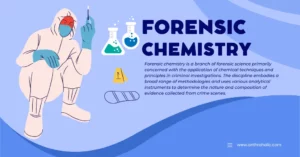AI Answer Evaluation Platform Live Now. Try Free Answer Evaluation Now
Forensic Toxicology
Forensic Toxicology is a branch of forensic science which deals with toxicological evidence. Forensic toxicology is the application of knowledge of toxins and its adverse effects on the living body in the court of law for the administration of justice. Traditionally, toxicology is defined as the science embodying the knowledge, source, character, fatal effect, lethal dose, analysis of poisons and the remedial measures.

When we are talking about toxicology, we need to mention the name of Mateau Joseph Bonaventura Orifila. He was the founder of modern toxicology due to his significant contribution. In some texts we might also find his name under the title of father of forensic toxicology as he published the first scientific treatise on the detection of poisons and its effect on animals. This work of M. Orifila opened the gate for forensic toxicology to be a legitimate scientific endeavour.
To understand the branch of forensic toxicology we first need to understand the basic difference between toxin, poison and venom. It is the misunderstanding of these terms that people use all these terms interchangeably.
Poison vs Toxin
“What is it that is not poison? All things are poison and nothing is without poison. It is the dose only that makes a thing not a poison”
Paracelsus
A poison is any substance that can be harmful or even deadly to a living organism. Poison can both be natural and man made. Poison can be both biological and chemical in nature and even a small amount of poison can be deadly.
Whereas toxins are a subcategory of poison that are natural in its origin. It can originate from both animal cells or plant cells. Ergo they are mostly biological in nature. Toxins are not as harmful as poison , until administered in the body at certain lethal or effective doses. The doses vary with each toxin from small , medium to large. A small dose of a certain toxin can be deadly whereas that same dose of other toxin can be ineffective. Also, combination of two toxic substances can be deadly whereas if they are administered individually they won’t be that much harmful.
For eg – If Alcohol is administered in a human body at low doses , it does not show a highly adverse effect. But when the dose increases its effect also increases in an adverse way. On the other hand, substances like Polonium 210 are lethal in extremely small doses, as small as less than 1 gm.
Furthermore, Venom is a subcategory of toxins that are specifically produced by animals inside their body. Such as snake venom, bee venom , Scorpio venom etc.
Effective Dose vs Lethal Dose.
The doses are often represented as ED0 , ED50 OR LD0, LD10, LD50. It signifies the doses at which individuals are affected or are expected to die. LD0 represents the dose at which no individual dies whereas LD50 represents the dose at which 50% of the tested individual died. LD50 is also sometimes termed as lethal dose.
Ergo, effective doses are used to represent the effectiveness of a substance. The effect could be both beneficial and harmful based on the substance and its dose. Whereas the lethal dose is only harmful in its effect except for LD0.
One more term i.e. TOXIC DOSES is also used at various places. It represents the dose at which adverse toxic effects of a substance could be seen.
Toxicological evidence and cases
The toxicological evidence material could be anything starting from body fluids like blood, saliva , urine, vomit , gastrointestinal fluid, faeces, viscera ( a piece of internal organ of body such as liver, spleen, kidney, stomach, heart, brain etc), tissue , vitreous humour, muscle, sample of drugs, syringe, needles, food leftovers, beverage, stomach content etc.
Cases that are mostly covered under toxicological division are :
- Poisoning related case ( it could be homicidal, suicidal, or even accidental ; both human and cattle poisoning)
- Unnatural death
- Suicide
- Drowning
- Death due to suffocation
- Acid attack
- Alcohol poisoning
- Drug abuse
- Adulterated drugs or medicine
Some important tools and techniques in Forensic Toxicology
The toxicological evidence first undergoes an extraction process by which it means to extract the tiniest amount of poison. In forensic we already know that the evidence that we get is in trace amounts. To extract the needed amount of sample we need to first perform the extraction process.
The extraction could be:
- Organic extraction ( Solvent extraction , Acid or alkaline digestion method)
- Distillation ( steam or fractional)
- Micro diffusion
- Dialysis
- Sublimation
- Microwave digestion
- Chromatography (TLC, HPLC, Paper , column , gas chromatography)
- Headspace purge and trap technique ( for volatile liquids)
- Supercritical fluid extraction.
- Hyphenated techniques ( HPLC- GC)
After extraction the extracted liquid is made to undergo various presumptive tests of metal and non metals and then confirmatory test is done using TLC and Gas chromatography coupled with mass spectrometry. It will help us to conclude the exact toxic substance present in the evidentiary sample and also the quantity of that sample. In most of the cases the report that is submitted in the court contains a chromatogram which is the graph plotted by GC-MS. It shows various peaks, the size of the peak indicates the quantity of each component reaching the detector of the gas chromatograph and the number of peaks shows different compounds present in the sample.
Conclusion
Forensic Toxicology is a wide and one of the most important branches of forensic science as well as most important divisions in forensic labs. The number of cases submitted to this division is also vast. The disposal of cases through this division and the way in which forensic toxicology helps in the administration of justice is also enormous and significant. New technological advancements and high end devices such as FTIR and hyphenated techniques are also on its way to make this branch of forensic science consequential in the near future.




